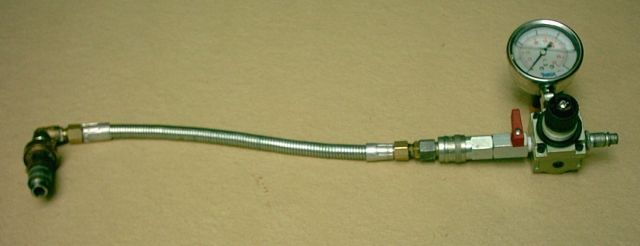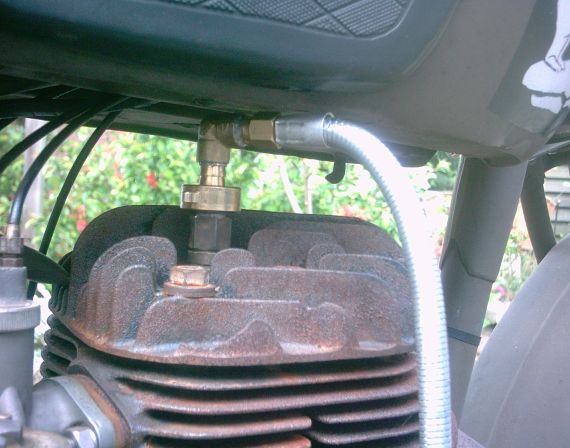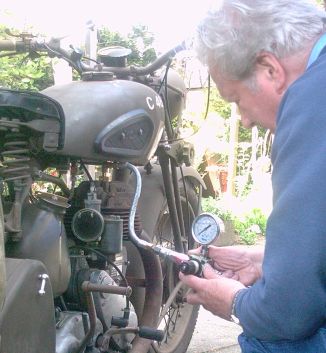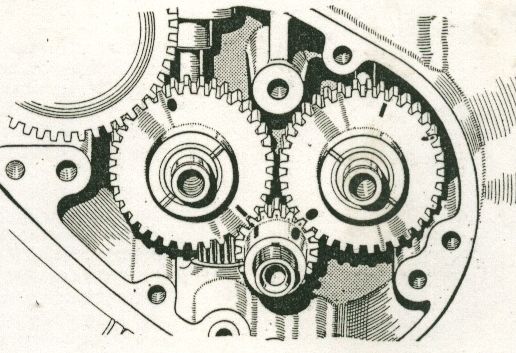The Leakdown Tester
By Hans MullerWDM20 58764
May 2007
With this simple tool you can test how much air leaks along the cylinder of your M20 (or any other classic or modern bike) and the valves. It is NOT a compression tester; that one will give only an impression how high your compression is, but not why it is low!
Construction
First of all, you need a compressor capable of giving at least 6 Bar or 100 PSI pressure, a pressure regulator, a pressure gage, a valve and some other small things the well-seasoned DIY guy has in his "Misc."-box, or can make from readily available parts in hardware stores.
The pressure gage on the compressor should be set to a slightly higher value than the maximum value on the tester, which in turn should preferably be set to a round figure, such as 5 Bar or 80 PSI. This 5 Bar or 80 PSI will be the 100% leak-free value.
Now, from the compressor onwards, you have the pressure regulator (usually furnished complete with a pressure gage), the valve, a piece of flexible hose, and an adapter made from a discarded spark plug. For obvious reasons it is important to make this adapter in two parts: the part that screws in the cylinder head, and the part that is fixed to the hose. The pictures give an idea how I did this; I am not sure if the garden hose connection I used is available outside the Netherlands, so you will have to improvise!

It is important that after the valve there is somewhere a damper (constriction) in the hose, with a small hole ( 1 - 1.5 mm), so that the air pressure cannot build up too quickly.
Use
- Put the gearbox in 4th, put the piston as near as possible in TDC position at full compression stroke and block it there by applying the footbrake. Be careful! Even a 5 Bar air pressure translates to more than 200 kg on the piston!
- Screw the adaptor in the cylinder head, and fix the hose to it, with the valve closed.
- Attach the compressor to the tester, and check if the reading is that round figure mentioned above; adjust if necessary.
- SLOWLY open the valve, and see the needle on the gage drop.
- Now listen (preferably using a stethoscope or piece of garden hose) where you hear a hissing noise, indicating loss of air:
- - at the exhaust? Burnt or not fully closing exhaust valve.
- - at the carburettor? Leaking inlet valve.
- - at the carter air release? Defective piston rings or undersize piston; if you suspect this, put some thick, heavy oil on the piston and repeat; if leaking is less, you can be sure you'll have to replace piston and/or rings.


Values
If the pressure goes down to 96 - 98%: congratulations! You have a motor fit for another 60 years of service. But below 92% something has to be done.
I had a problem in that I could not sufficiently prevent the piston from moving; this resulted in slowly opening the exhaust valve. I solved this by temporarily removing the exhaust timing gear. But don't forget to replace it in its correct position: point on point and dash on dash as in figure below.

If you find bad results with a cold engine, try also after warming it up; usually, results will be better. And a further test consists of allowing the piston to go down slowly, backwards from compression full compression stroke; this may give an indication about local wear of the cylinder.